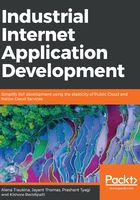
上QQ阅读APP看书,第一时间看更新
Application-level protocols – WebSocket
In this section, we will try to build a simple IoT app for sending data from an XD-80 light sensor module to a receiver device, using a Raspberry Pi hub and the WebSocket protocol:

Data flow from an XD-80 sensor to a receiver device
WebSocket is most widely used in the case that one needs to enable fast transfer of real-time data. The protocol allows for two-way interaction between a client and a server, and for streaming multiple messages using the same TCP connection, which lowers the communications overhead.
In the following table, you can find a more detailed description of the protocol to understand whether it is suitable for your needs:
Key Value
Open source Yes
The OSI layer Application
Data types String
Limitations Not suitable for large amounts of binary data
Possible operations Send/receive data
Latency Very low
Usage Real-time communication
Security Yes
Compression Yes
Table 3: WebSocket protocol specifications
For building the application, we will need the following.
Required software:
- Node.js 6+ (https://nodejs.org/en/download/)
- RPIO (https://www.npmjs.com/package/rpio)
- WebSocket (https://www.npmjs.com/package/ws)
- Docker (https://docs.docker.com/engine/installation/)
Required hardware:
- Raspberry Pi 3 (model B)
- A power adapter (2A/5V)
- A microSD card (8 GB+) and an SD adapter
- A XD-80 light sensor module
- A breadboard and a set of dupont cables
- An Ethernet cable for a wired network connection